Bad pickleball lighting causes missed shots, eye strain, and safety risks. The right LED lighting setup fixes this and transforms play quality.
Pickleball court lighting design and cost depend on court type, fixture selection, and compliance with lighting standards. A proper layout includes correct pole height, lumens output, beam angles, and glare control. For outdoor courts, 200–300 lux is common, while indoor courts may require higher levels for competitive play. Installation costs for new LED setups typically range from $8,000 to $20,000, while retrofits cost less. Energy-efficient LEDs reduce maintenance, operating costs, and improve the overall playing experience for both casual and competitive players.
Let’s walk through everything you need to know before investing.
Table of Contents
What is Pickleball Court Lighting?
Pickleball court lighting refers to the artificial lighting systems installed to make a pickleball court usable in low-light or nighttime conditions, as well as in indoor facilities without enough natural light. These lighting setups are designed to provide bright, uniform illumination across the entire court so players can see the ball, lines, and each other clearly without glare or shadows.
Unlike casual garden or backyard lighting, pickleball court lighting must meet specific brightness, uniformity, and glare control standards. For a standard-size pickleball court (6.1 meters by 13.4 meters), the lighting should ensure the entire playing surface is evenly lit from baseline to baseline and sideline to sideline. The goal is to create visibility that supports fast-paced play and quick reactions while also being comfortable for the eyes.
Lighting can be installed outdoors using weatherproof LED flood lights mounted on poles or indoors using high bay or suspended LED fixtures. The exact type of lighting chosen depends on whether the court is used for recreational play, competitive matches, or televised events, as different scenarios require different light levels and quality.
Good pickleball court lighting doesn’t just improve visibility—it enhances safety, reduces the risk of missed shots due to poor lighting, and creates a more enjoyable playing experience for everyone on the court.

LED Pickleball Court Lighting Layout
A well-designed LED pickleball court lighting layout is key to ensuring players have clear visibility without distractions from glare or uneven lighting. For most standard-size pickleball courts, the common setup uses four poles, with each pole supporting two high-quality LED fixtures. This arrangement is positioned to provide consistent light levels across the entire playing surface while avoiding dark corners or overly bright hot spots.
Poles are typically placed outside the court boundaries, often at the sides near the corners. This placement prevents fixtures from interfering with play and reduces the risk of direct glare in a player’s eyes. For backyard or residential pickleball courts, careful attention should be given to the angle of each fixture. The goal is to direct light precisely onto the court, keeping it from spilling into neighboring properties and avoiding light trespass issues.
The fixtures themselves should be mounted at an appropriate height—usually between 6 and 8 meters—to allow for optimal beam spread and to ensure shadows are minimized. Asymmetric optics or specially designed sports lighting lenses can help distribute light evenly across the court while enhancing visibility for fast-moving balls. By combining the right fixture placement, mounting height, and beam angle, you can create a lighting layout that meets both performance and comfort needs for pickleball players.
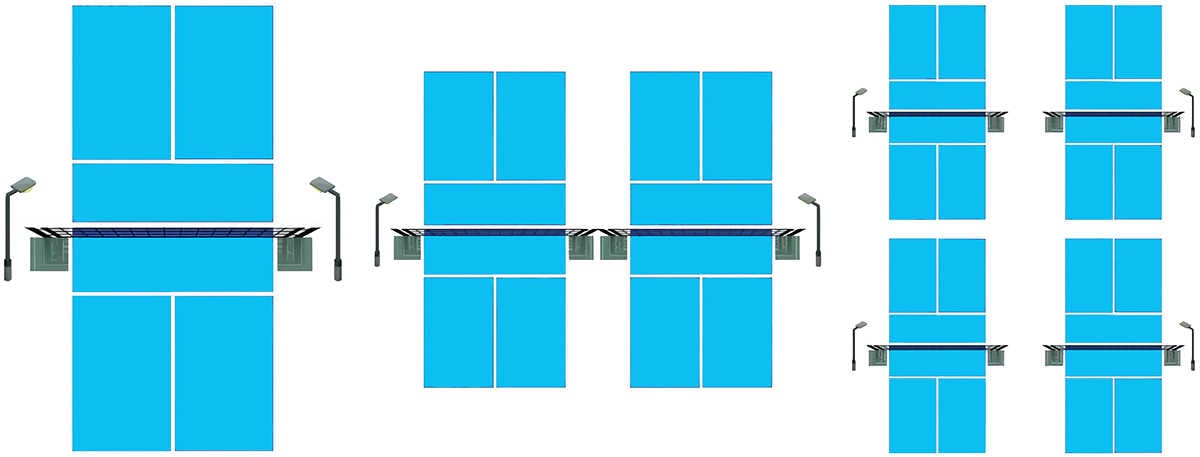
Pickleball Court 2 Poles

Pickleball Court 4 Poles
Pickleball Court Lighting Standards and Requirements
No matter the location, the primary lighting need is “safety first,” ensuring the area is well-lit. However, what constitutes “sufficient light” varies based on the pickleball court’s competition level. Pickleball is divided into three classes: Class I(Professional), Class II(Club/Competition), and Class III(Recreational). Here’s a breakdown with recommended lighting levels:
Class I(Professional)
Class I covers professional pickleball matches, demanding the highest level of lighting. These events may attract large audiences watching from afar, and are often televised. For this class, 750 lux average horizontal illumination and 450 lux average vertical illumination are ideal.
Class II(Club/Competition)
Class II involves club competitions. Here, a moderate number of spectators view the game from a medium distance. Suitable lighting for these matches is 500 lux average horizontal illumination and 350 lux average vertical illumination.
Class III(Recreational)
Class III covers recreational pickleball, general training, and school sports, typically with few spectators. For this level, 300 lux average horizontal illumination and 200 lux average vertical illumination are considered sufficient.
| Level of Play | Avg. Lux | Uniformity (max/min) | Mounting Height | CCT | CRI |
|---|---|---|---|---|---|
| Recreational | 320 | ≤2.0 | ≥6 meters | 4000K | >70 |
| Club/Competition | 485–540 | ≤2.0 | ≥6 meters | 5000K | >70 |
| Professional | 750–810 | ≤1.7 | ≥6 meters | 5000K | >70 |
Horizontal illuminance
Horizontal illuminance measures how much light falls evenly across the court surface, helping players see lines, the ball, and their surroundings clearly. For recreational play, a minimum of 300 lux is generally recommended. This ensures that casual matches are well-lit without over-illumination. For competitive or tournament play, the requirement rises to 500 lux or more, as higher brightness improves reaction time and precision. Uniformity is just as important as brightness—aim for a uniformity ratio of at least 0.6 (minimum lux divided by average lux). This prevents areas of the court from appearing dimmer or brighter than others, which can disrupt gameplay.
Vertical illuminance
Vertical illuminance measures how well players can see objects—especially the ball—when it is in the air. This is critical for a sport like pickleball, where the ball spends a lot of time above the players’ heads. For competitive play, vertical illuminance levels of at least 350 lux are preferred, measured from the player’s eye level toward different points on the court. Adequate vertical lighting helps players maintain visibility of the ball at all stages of flight and ensures quick, accurate responses during rallies. Both horizontal and vertical illuminance should be addressed in a proper lighting design to guarantee a safe, enjoyable, and professional playing environment.
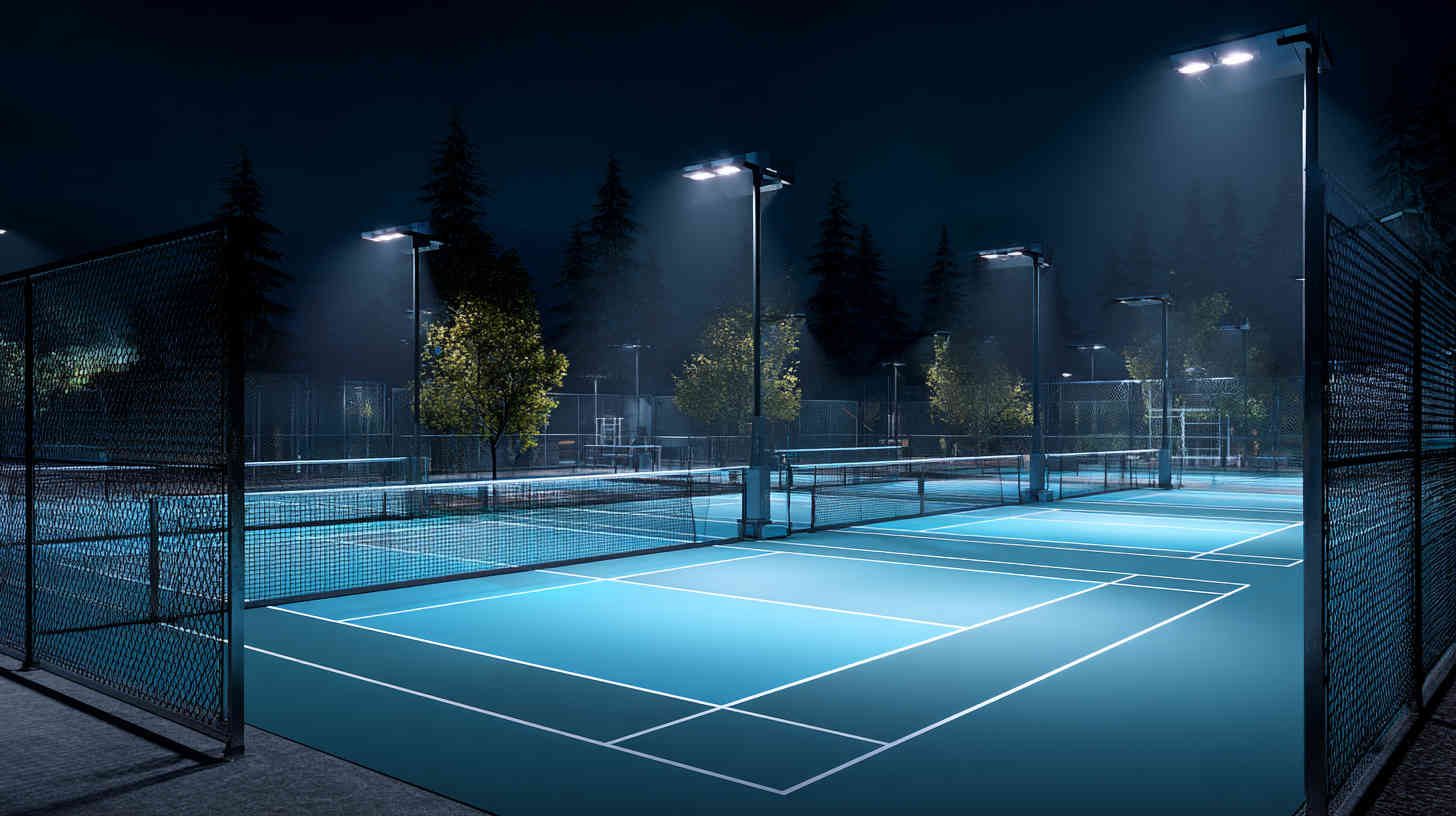
Key considerations about pickleball lighting fixtures
Control system
Modern LED pickleball lighting can be paired with smart control systems that make managing energy use simple and efficient. These systems allow you to schedule lights to turn on only during booked court hours, dim them during non-peak times, or even activate them automatically with motion sensors when players arrive. This helps cut operating costs while ensuring the lights are always ready when needed.
Color temperature
The ideal color temperature for pickleball lighting falls between 4000K and 5000K. This range provides a bright, neutral white light that closely matches natural daylight, which improves visibility and reduces eye strain. It works well for both indoor and outdoor courts, giving players consistent lighting conditions across different environments.
Color rendering
A Color Rendering Index (CRI) above 80 is recommended for pickleball lighting. High CRI ensures that colors—such as the yellow ball, court markings, and player apparel—appear natural and accurate under the lights. This not only improves visual comfort but also helps players react faster during fast-paced rallies.
Photometric study
Before installation, it’s crucial to perform a photometric study. This computer-based lighting simulation models the court and predicts exactly how the fixtures will perform, measuring brightness, uniformity, glare levels, and spill light. It ensures the design meets lighting standards and provides even coverage without hot spots or dark areas.
Non-Glare LEDs
High-quality pickleball lighting fixtures use special lens optics and beam control to reduce glare. This ensures the light reaches the playing surface without shining directly into players’ eyes. Glare control is essential for competitive matches, where clear vision and reaction speed make a big difference.
Spill light
For outdoor courts—especially in residential areas—minimizing light spill into neighboring properties is a must. Fixtures with precision optics and optional shielding direct light exactly where it’s needed and prevent light trespass. This not only improves player focus but also keeps neighbors happy and reduces wasted energy.
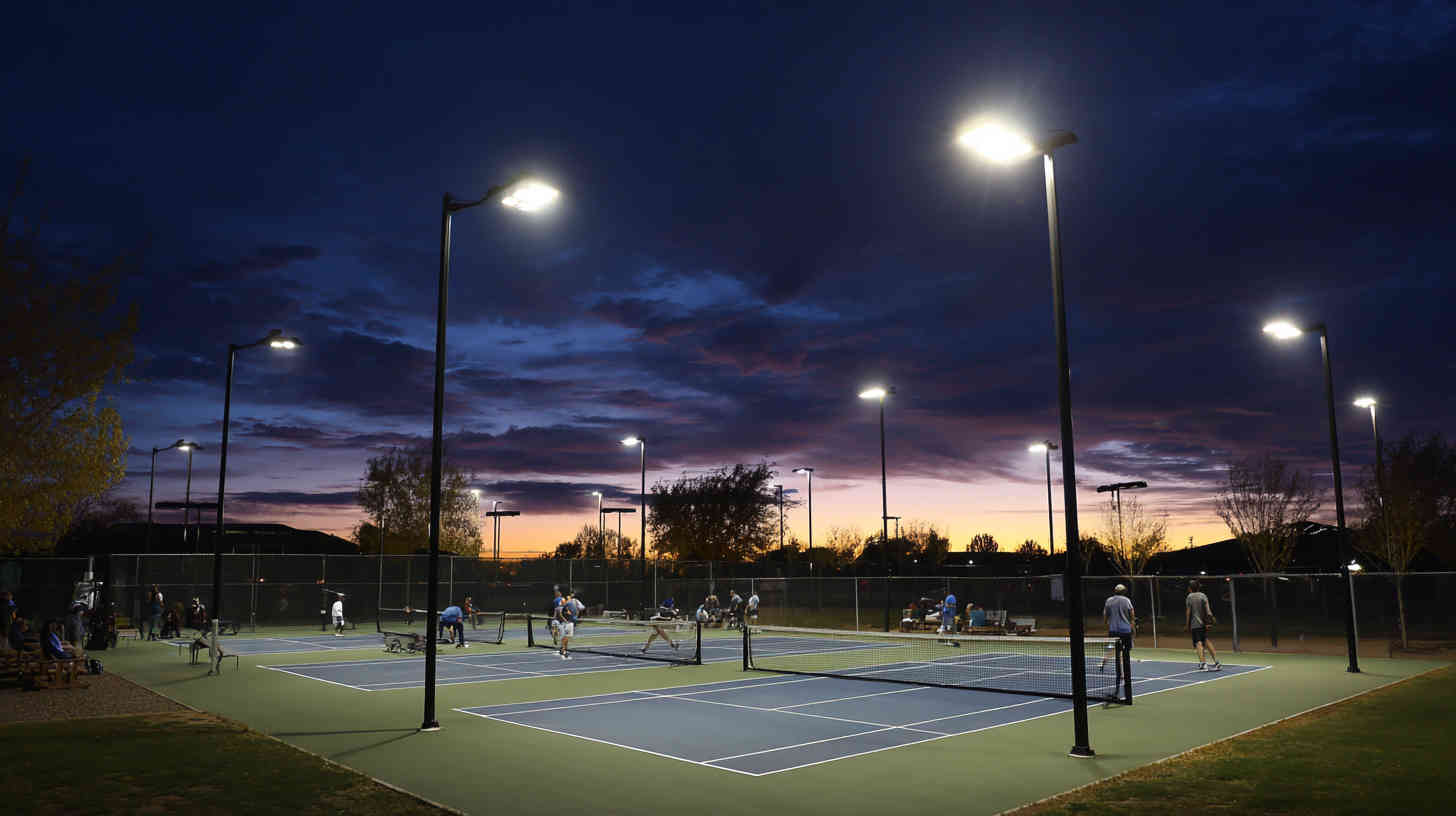
Optimal Height and Placement of Pickleball Court Lights
Suggested Heights for Light Placement
For outdoor pickleball courts, the recommended pole height is between 6 and 8 meters. This height provides a balance between wide light coverage and reduced glare. Taller poles can improve uniformity by spreading light more evenly, but going too high can waste energy and create light spill beyond the court. For indoor courts, fixtures are typically mounted on ceilings or overhead structures at similar heights, ensuring the beam angles and optics are optimized for the lower mounting position.
If multiple courts are placed side by side, poles or fixtures should be high enough to cover each court without causing shadows from nearby structures or equipment.
Preventing Shadows and Glare
The placement of pickleball court lights is just as important as their height. Fixtures should be installed symmetrically along both sidelines, usually in pairs, so that each side of the court receives balanced light. Avoid placing lights directly behind baselines or in the line of sight of players, as this can cause glare and make it difficult to track the ball.
Angling the lights slightly downward and using asymmetric beam optics helps concentrate light on the court while reducing direct light into players’ eyes. Proper aiming also minimizes unwanted shadows, especially in the middle of the court where play is most active. In competitive or high-level setups, additional glare control accessories like visors or shields can be installed to enhance player comfort.
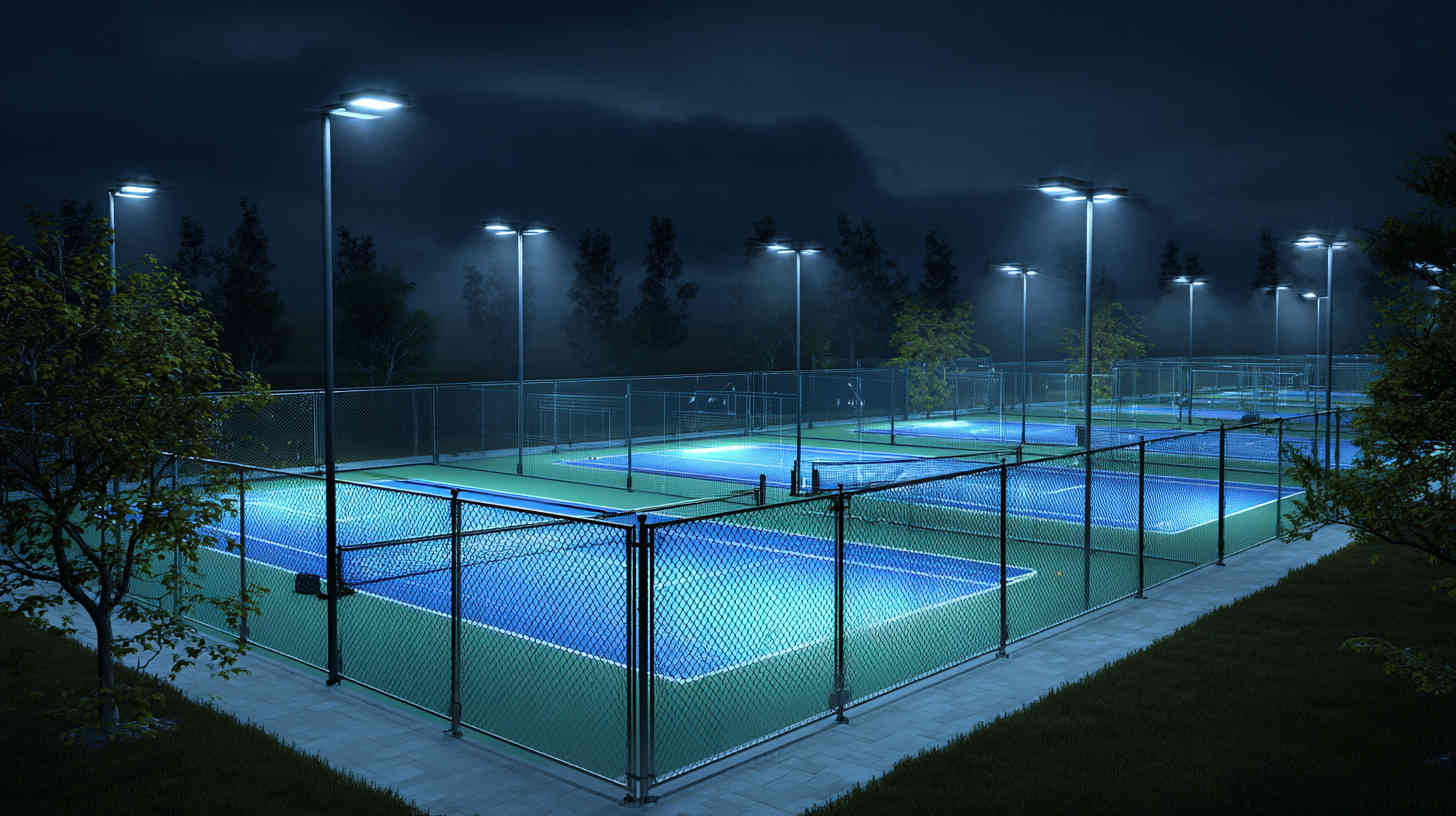
Benefits of LED Pickleball Court Lighting
LED pickleball court lighting offers a combination of performance, efficiency, and reliability that older lighting technologies simply can’t match. One of the biggest advantages is energy efficiency—LED fixtures can use up to 70% less electricity compared to traditional metal halide or halogen lamps. This means lower monthly utility bills, which can be a significant saving for clubs, communities, or private court owners.
The long lifespan of LEDs is another major benefit. Quality LED sports lights often last 50,000 hours or more, which could mean over a decade of use before replacement is needed. This reduces both maintenance costs and the inconvenience of frequent relamping—especially important for lights mounted on tall poles or ceilings.
LEDs also deliver instant-on performance. Unlike metal halide lights, which can take several minutes to reach full brightness, LEDs turn on immediately with no warm-up period. This is particularly useful for evening play or when courts are used intermittently.
Color quality is another strong point. With high CRI (Color Rendering Index) values, typically 80 or above, LEDs provide accurate color visibility. This helps players clearly see the ball, court lines, and surroundings, improving both gameplay and safety.
In addition, LEDs are highly controllable. They can be dimmed or paired with smart control systems for scheduling, motion sensing, and energy-saving modes. Combined with their durability, weather resistance, and precision optics for glare reduction, LED lighting provides a long-term, cost-effective solution for any pickleball court.
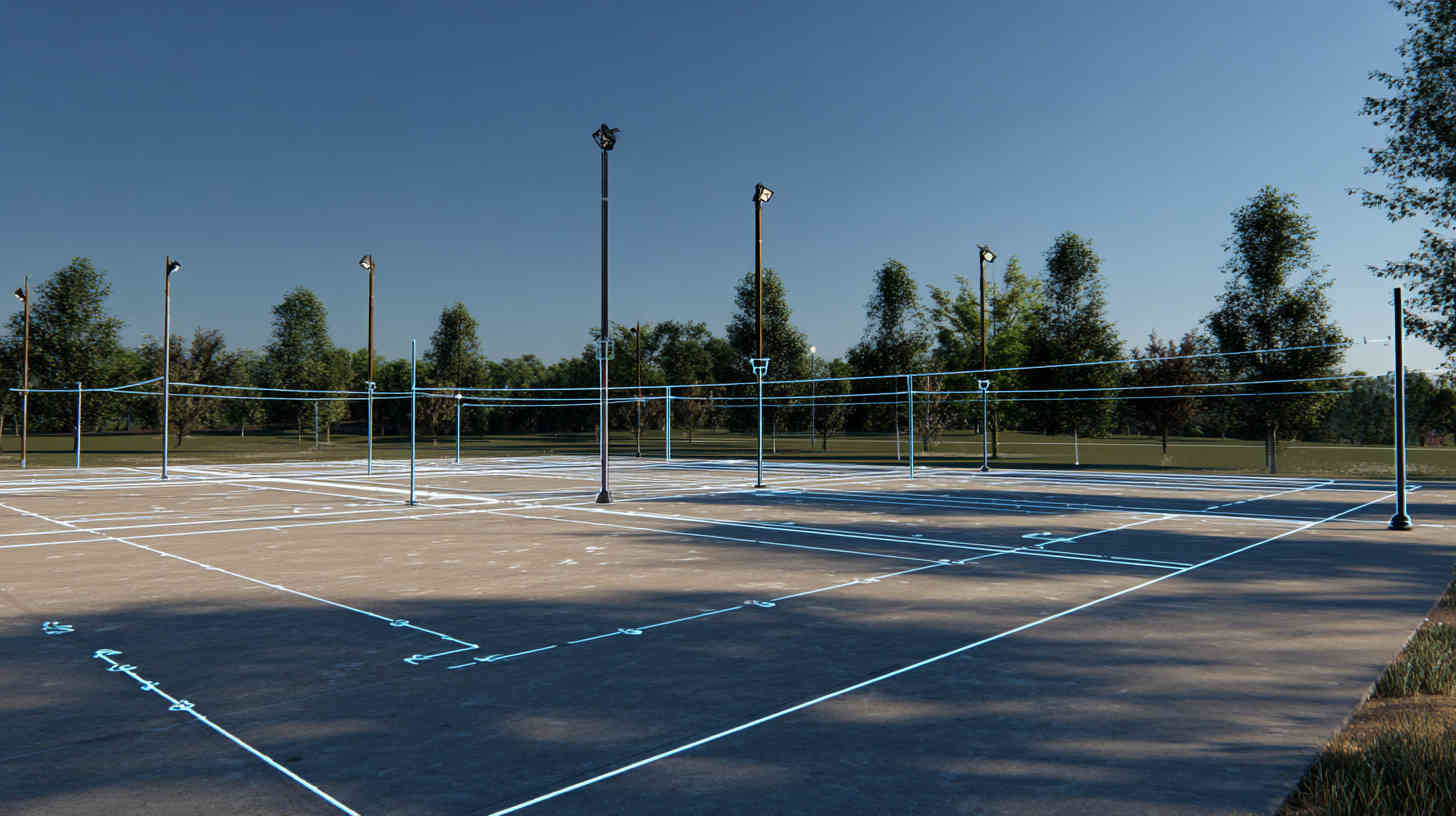
Choosing the Right Lighting for Indoor vs. Outdoor Pickleball Courts
Indoor Pickleball Court Lighting
Lighting for indoor pickleball courts needs to balance brightness, uniformity, and visual comfort. High bay LED fixtures are often the best choice, as they can deliver powerful, even illumination from heights of 6–12 meters. These fixtures should be designed with proper optics to minimize glare and shadowing, ensuring players have clear visibility of the ball at all times. For competitive play or events that may be recorded, flicker-free LED drivers are essential to prevent issues with both human perception and camera capture. Color temperature in the range of 4000K to 5000K provides a neutral white light that enhances visibility without being harsh. CRI values of 80 or higher help ensure that court lines, the ball, and player movements appear natural and vibrant.
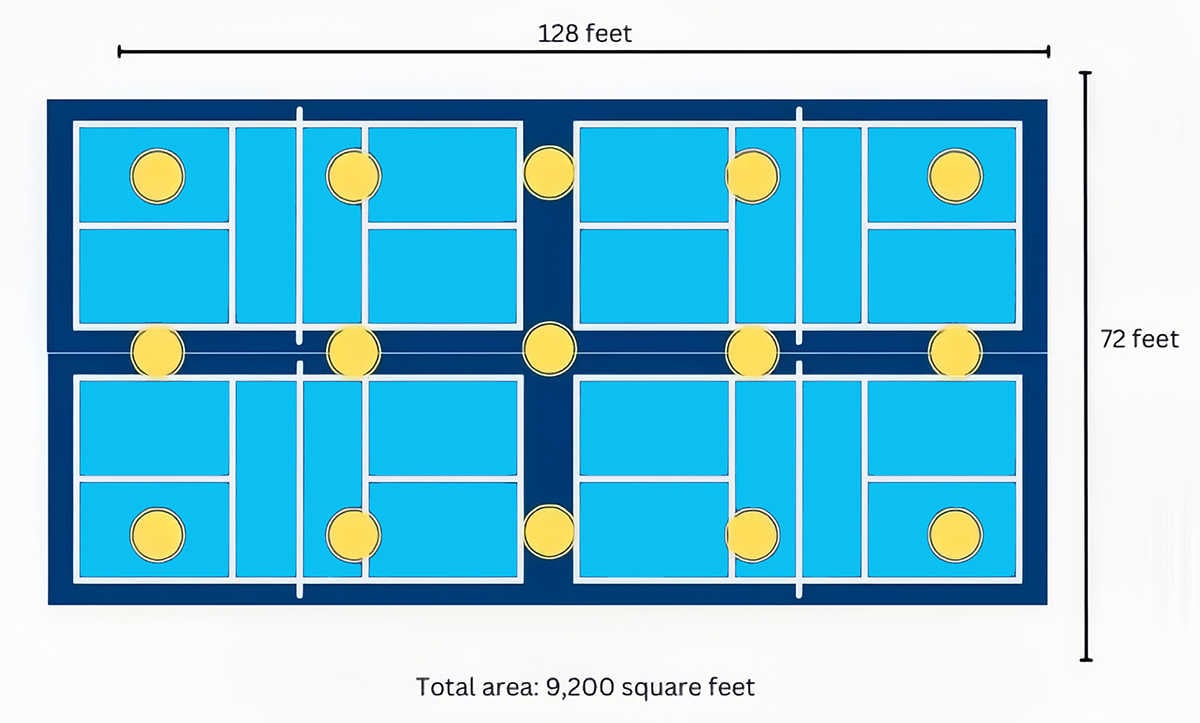
Indoor Pickleball Court Lighting
Outdoor Pickleball Court Lighting
Outdoor pickleball courts face unique challenges such as rain, wind, dust, and temperature fluctuations, so fixtures must be built to withstand these conditions. Weatherproof LED flood lights with an IP65 or higher rating are ideal, offering durability and resistance to moisture and debris. These lights are typically mounted on 6–8 meter poles positioned outside the playing area to avoid interference and reduce glare. Precision optics, such as asymmetric lenses, help direct light evenly across the court while minimizing spill light into neighboring areas—a key concern for community or backyard courts. High lumen output with proper beam angles ensures that the entire court is illuminated to the required lux levels for recreational or competitive play. Surge protection and corrosion-resistant housings are also recommended for outdoor installations to ensure long-term performance.
LED Pickleball Court Lighting New Installation Cost
The cost of installing LED lighting for a new pickleball court can vary widely depending on factors such as the size of the court, the number of poles, the type of LED fixtures chosen, and the level of play the court is intended for. On average, a complete professional-grade installation will range from $8,000 to $20,000 per court. This estimate includes the purchase and installation of lighting poles (usually 6–8 meters high), high-quality LED flood lights or high bay fixtures, electrical wiring, mounting hardware, and a suitable lighting control system.
Higher-end installations—designed for competitive or tournament-level play—often include advanced control features like dimming, scheduling, and motion sensors, which can increase costs toward the upper end of the range. Backyard pickleball court lighting setups tend to be less expensive, often between $4,000 and $10,000, because they require fewer fixtures, shorter poles, and simpler control systems.
Labor and installation costs will also vary based on local conditions, the need for trenching or electrical upgrades, and whether the project is indoors or outdoors. For outdoor installations, additional expenses may include weatherproofing measures, surge protection, and glare shields to ensure both durability and compliance with local lighting regulations.
LED Retrofit Cost for Pickleball Court Lighting
Retrofitting an existing pickleball court with LED lighting is a cost-effective way to upgrade performance without replacing the entire infrastructure. In most cases, the existing poles, brackets, and wiring can be reused, which significantly reduces overall expenses. The main investment is in replacing the old metal halide, halogen, or fluorescent fixtures with new, energy-efficient LED units.
Typical retrofit costs range from $5,000 to $12,000 per court, depending on the number of fixtures needed, their wattage, and the quality of the LEDs selected. Lower-cost retrofits may involve basic fixture replacements, while higher-end projects can include precision optics for better light distribution, anti-glare shields, and advanced control systems like dimming or motion sensors.
One of the biggest financial advantages of an LED retrofit is the immediate reduction in energy consumption—often by 50–70%—which translates into significant monthly savings on electricity bills. LEDs also have a much longer lifespan than older lighting technologies, meaning fewer replacements and lower maintenance costs over the years. This combination of reduced operating expenses and improved lighting quality makes LED retrofits a smart investment for both recreational and professional pickleball facilities.
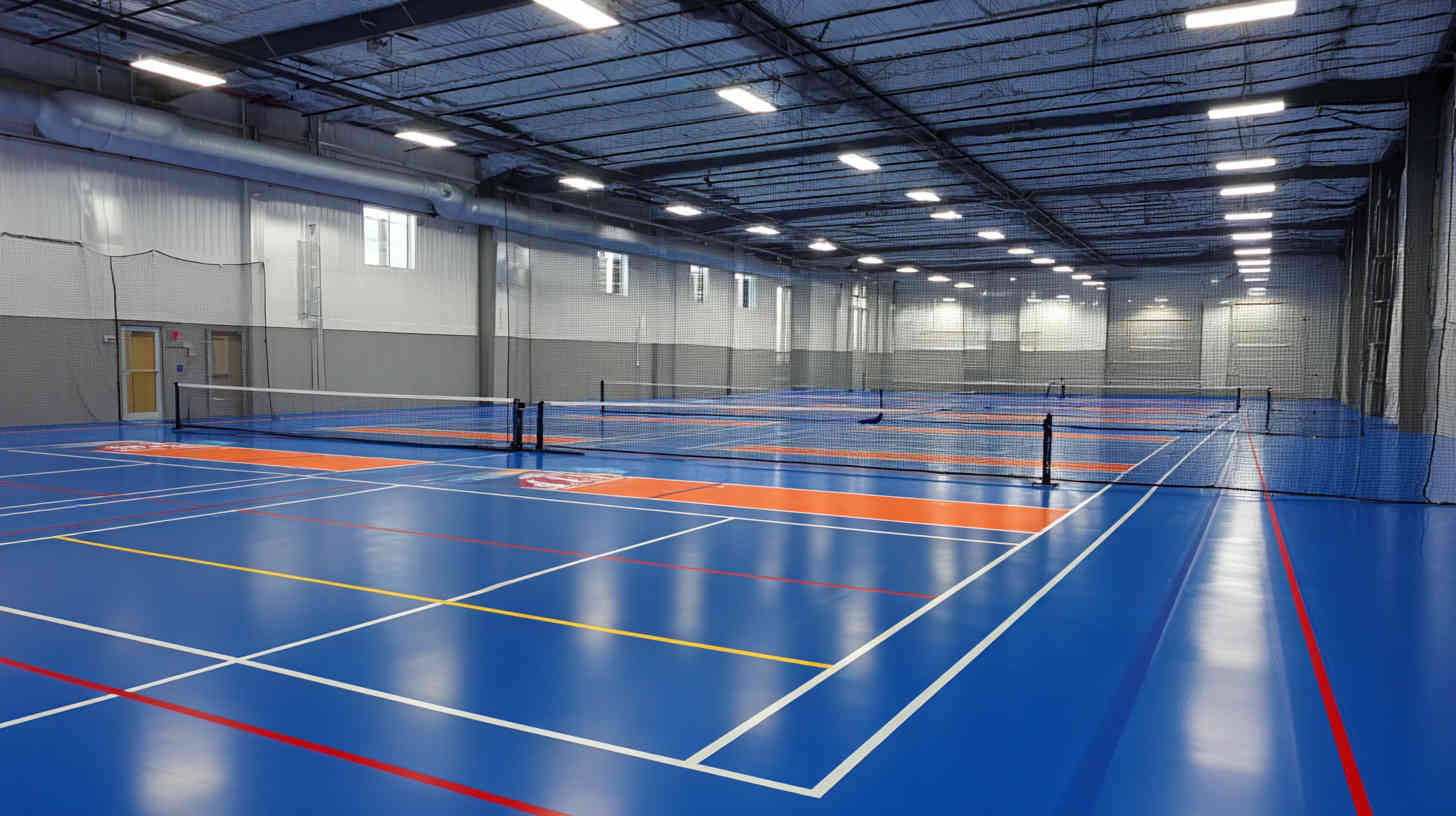
Pickleball Court Lighting Maintenance Cost
One of the key advantages of LED pickleball court lighting is its low maintenance requirement compared to older systems like metal halide or halogen. LEDs have no fragile filaments or gas-filled tubes that burn out quickly, so replacements are rare. Most high-quality LED fixtures last 50,000 hours or more, meaning they can run for years before any major servicing is needed.
Annual maintenance typically involves basic cleaning of the fixture lenses and housing to remove dust, dirt, and insect buildup that can reduce light output. For outdoor courts, this might also include removing bird nests, cobwebs, or pollen. Cleaning not only keeps the court looking professional but also maintains optimal brightness and uniformity.
Occasional driver replacements may be required over the lifespan of the fixture, as LED drivers generally have a shorter life than the LEDs themselves. Control systems, especially those with timers, dimmers, or motion sensors, should be checked at least once a year to ensure proper operation and energy savings.
Overall, maintenance costs for LED pickleball court lighting are minimal—often just a fraction of what’s needed for traditional systems. With routine care and timely servicing, these lights can provide consistent performance and excellent visibility for many years without costly downtime or frequent replacements.
FAQs about Pickleball Court Lighting
What are the standard dimensions of a pickleball court?
A regulation pickleball court measures 6.1 meters (20 feet) in width and 13.4 meters (44 feet) in length. These dimensions include the playing area and follow official guidelines for both recreational and competitive play.
How many LED light fixtures do I need for my pickleball court?
Most courts use between 4 and 8 LED fixtures, depending on the desired brightness, beam angle, and mounting height. Recreational courts can often work with fewer fixtures if the lumen output is high, while competitive courts benefit from more fixtures for better uniformity.
How Much Does It Cost to Replace Old LED Pickleball Court Lights?
If you’re swapping out existing LED fixtures for new ones, expect to pay between $500 and $1,500 per fixture. The price varies based on wattage, lumen output, optics, and brand reputation. High-quality sports lighting brands typically cost more upfront but offer longer life and better performance.
What’s the Best Option for Lighting Your Pickleball Court?
For outdoor pickleball courts, IP65-rated or higher LED flood lights are ideal because they withstand rain, dust, and temperature changes. For indoor courts, high bay LED fixtures with a high CRI (80+) ensure accurate color visibility and excellent ball tracking.
What is the height of the pickleball lighting?
Outdoor courts usually have poles between 6 and 8 meters high, placed strategically to avoid glare. Indoor courts use ceiling-mounted fixtures at equivalent heights, depending on building structure.
How many lumens do I need to light a pickleball court?
For recreational play, around 50,000–60,000 lumens in total is typically enough. Competitive play or tournament settings may require higher lumen output to meet stricter lux and uniformity standards.
How high of a ceiling do you need for a pickleball court?
Indoor pickleball courts should have a minimum ceiling clearance of 7–8 meters. This allows enough space for optimal light spread, reduces glare, and prevents interference with gameplay.

Conclusion
Well-planned LED pickleball court lighting improves visibility, reduces energy costs, and ensures players enjoy every game safely. Whether it’s a backyard setup or a competitive venue, the right design makes all the difference.
If you need a professional pickleball court lighting plan or cost estimate, contact Logos Lighting today—we’ll make sure your court shines bright.
Request A Free Quote Now!
Send us a message if you have any questions or request a quote. We will get back to you ASAP!















